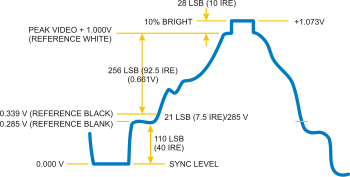IRE (unit)

Diagram of composite video field with IRE measurements
An IRE is a unit used in the measurement of composite video signals. Its name is derived from the initials of the Institute of Radio Engineers.[1]
A value of 100 IRE was originally defined to be the range from black to white in a video signal. A value of 0 IRE corresponds to the voltage value of the signal during the blanking period. The sync pulse is normally 40 IRE below this 0 IRE value, so the total range covered from peak to trough of an all white signal would be 140 IRE.
The reason IRE is a relative measurement (percent) is because a video signal may be any amplitude. This unit is used in the ITU-R BT.470 which defines PAL, NTSC and SECAM.[2]
References
- ↑ Robin & Poulin; Michael Robin; Michel Poulin (2000). Digital television fundamentals: design and installation of video and audio systems. McGraw-Hill Professional. p. 17. ISBN 0-07-135581-2.
- ↑ "BT.470 : Conventional analogue television systems". International Telecommunications Union. Retrieved 28 August 2012.
This article is issued from Wikipedia - version of the 10/15/2016. The text is available under the Creative Commons Attribution/Share Alike but additional terms may apply for the media files.